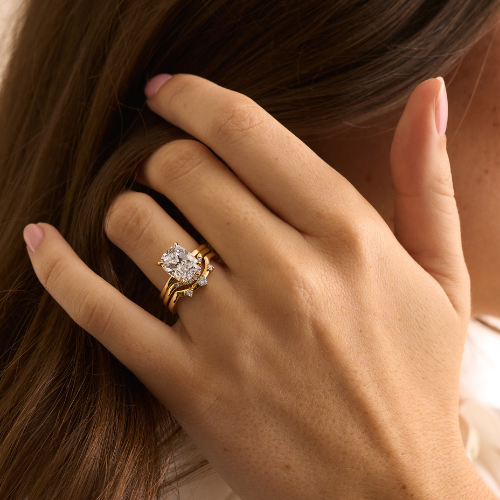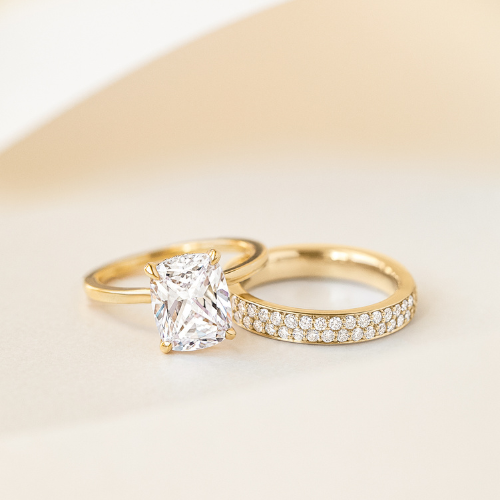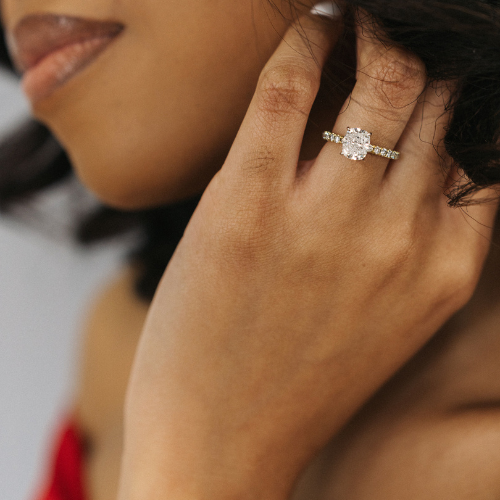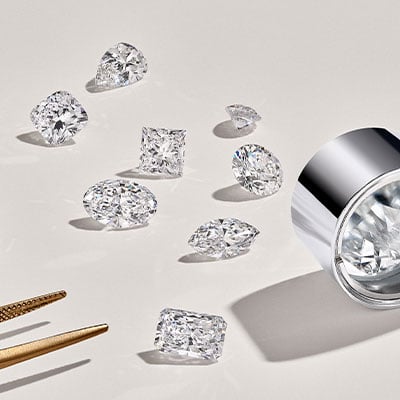
The effortless elegance of the cushion cut engagement ring is trending, but with a fresh modern twist. An elongated version of cushion diamonds has the same rounded corners of its romantic pillowy namesake, but the stone has added length. That means even more brilliance and a rare, fashionable find. Here’s what to love about the elongated cushion cut (and why you might want to choose it for an engagement ring).
What is an elongated cushion cut diamond?
Cushion diamonds are the original diamond cut – even older than round brilliant diamonds! While they are both square, when looking at princess cut vs. cushion cut diamond engagement rings, you’ll see that cushion diamonds have a much softer look, as their name implies. Elongated cushion cut diamonds have the rounded corners of a classic cushion cut diamond but with a longer diamond shape. Elongated cushion diamonds have a more rectangular appearance, similar to an emerald cut or radiant cut diamond, instead of the more vintage square shape of a classic cushion. They still have the brilliant cut faceting that gives a cushion diamond its exceptional shine, but the longer dimensions exceed that perfect square ratio of 1:1. Many people also love this shape because it’s flattering, as elongated shapes can also help elongate the look of a person’s fingers. So, if you like the look of emerald cut diamonds but want a softer, more sparkling option, look to the elongated cushion cut for your engagement ring.
Are elongated cushion diamonds rare?
Elongated cushion diamonds are cut less often than classic cushion diamonds are, and the more elongated the shape the less common it will be. Slight extensions of 1.15 and below are common, while extra tall and slender proportions (anything with a length-to-width ratio over 1.5) aren’t produced as much or as often.
But if you love the look of elongated cushions, don’t worry! It’s definitely not impossible to find an elongated cushion diamond that fits your style, budget, and needs. For couples looking to get the most diamond for their dollar, looking at lab created diamonds, especially when you’re buying your engagement ring online, can help you get a show-stopping look for less. You can design an engagement ring from scratch using an elongated cushion diamond as the center to match your vision of your dream ring.

Are elongated diamonds more expensive?
Elongated cushion diamonds are not necessarily more expensive than the square cushion cut (it’s has more to do with your diamond’s 4 Cs), but typically these shapes run 25% to 50% less costly than a round cut diamond with the same carat weight.
One reason people opt for an elongated cut over a classic cushion is because its dimensions can make your diamond look larger at the same carat weight. Traditional cushion diamonds are known to hold their weight deeper than most other diamond shapes. Carat is a measurement of weight and not dimension, so a diamond that holds its weight at its bottom will appear smaller than diamonds that have more balanced weight distribution. By elongating the cushion, the weight gets distributed more evenly and can make your diamond appear larger.
It’s up to you to decide what fits your budget and aesthetic! Your ring’s cost will always come down to the combination of the 4 Cs of diamonds, rather than just one quality. You can use our diamond buying guide to decide which features stand out to you (and onlookers) and choose a price range from there.
What is the L/W ratio for an elongated cushion cut diamond?
For a diamond to qualify as an elongated cushion cut, it has to noticeably defy the boundaries of that symmetrical square shape. Elongated cuts need to be at least 1.1 to push them over the edge, so to speak, so that one side surpasses the other. For many people, ratios of 1.1 will still look square and anything over 1.5 will look very skinny – closer to an oval diamond than a cushion. What you should choose will depend on if you want a wider or skinnier look, but most elongated diamonds have a ratio between 1.15 and 1.4.
Another helpful way to judge an elongated cushion’s shape is to look at its actual millimeter dimensions. This will precisely show you how many millimeters long vs. wide the diamond is. For help seeing the approximate length to width measurements for different carat weights, you can refer to a mm to carat conversion chart.
Pros of Elongated Cushion Cut Engagement Rings
- Brilliant Sparkle: Elongated cushion diamonds are more likely to have a “crushed ice” look to their faceting pattern. This unique look is becoming more and more popular for the dazzling fire and brilliance it creates. In general, cushion diamonds have large internal facets that are great for light-play and encourage a lot of sparkle. Optimizing for the diamond cut quality of your elongated diamond will impact its scintillation.
- Enlarged Appearance: These diamonds look bigger face-up than the classic cushion cut, but even for their own carat weight, they have the illusion of a bit more heft. To dramatize the size even further, consider choosing a band with pavé diamonds or a halo around the center gem.
- Durable: Rounded corners are less likely to chip. And they appear less angular, which is desirable if you prefer a look that’s soft vs. sharp.
Cons of Elongated Cushion Cut Engagement Rings
- Less Common: This might not be a con if you prize originality, but it does mean you might be in for a waiting game if you want an extremely elongated diamond or an elongated cushion with very specific criteria for its cut, color, clarity, carat weight, and other qualities.
- Visible Imperfections: The open table of an elongated cushion cut puts any inclusions — those internal flaws — on display. An easy fix? Opt for a clarity rating of at least VS2 for a diamond with an eye-clean appearance.
- Color: If you care about having a bright white diamond, pay attention to an elongated cut’s color grade. These elongated shapes can hold more color and reflect more diamond fluorescence than other cuts, so you’ll have to budget more for color if it’s important to you. However, how warm or cool a diamond appears is always a matter of preference, and having a bit of color in a diamond isn’t necessarily a bad thing. Of course, this caution only applies to white diamonds rather than a colored diamond or gemstone.

How do you choose an elongated cushion cut engagement ring?
1. Budget
As with any engagement ring, budget will play a big role in decision making. Decide which of the diamond 4 Cs are most important to you in your elongated cushion diamond, and optimize your search based on those. For couples looking for a more cost effective option, look into engagement ring alternatives such as moissanite vs. diamond or consider an ethically sourced lab grown cushion diamond. Lab created diamonds are real diamonds and are optically, physically, and chemically identical to mined diamonds, but with a smaller price tag. Moissanite is a diamond simulant that has its own unique fire and brilliance.
2. Gemstone
If you prefer cushion gemstones over traditional diamond, moissanite, sapphire, ruby, spinel, and garnet are all hardy and rank high on the Mohs scale, making them perfectly suited for daily wear. For any colored gemstone, look to a ratio of 1.4 and above for a pronounced shape in your elongated cushion cut gemstones.
3. Length to Width Ratio
As mentioned above, the length to width ratio you choose will greatly affect the appearance of your elongated cushion gem. In order to get a noticeably elongated shape, shoot for 1.15 to 1.20. Take note that anything from 1.06 to 1.10 can appear imbalanced rather than intentional and anything over 1.5 will look very skinny.
4. Remaining 4 Cs
All the 4 Cs, cut, color, clarity, and carat will affect the overall cost and appearance of your elongated cushion diamond. When planning and budgeting, decide which qualities you and your partner care most about for your unique ring. Diamond cut is one we always recommend optimizing for because it affects the fire, brilliance, and overall quality of the stone. In terms of diamond clarity, look at diamonds VS2 or above so you don’t see blemishes within your stone (although many SI1 diamond will also be eye clean). For diamond color, J through G diamonds are considered near colorless F and E are colorless, and D is pure icy white. As for carat, remember that while it does generally indicate how large your diamond will appear, it’s actually a measurement of weight rather than surface area. For the most accurate indication of size for elongated shapes, we recommend looking at the diamond’s dimensions in millimeters and its length to width ratio.
5. Setting
Sleek and bold, the shape of an elongated cushion cut retains the old-school faceting pattern and antique elegance of a cushion but with a modern twist. These diamonds deserve a ring setting to match! To make the most of your diamond’s brightness and beauty, refine your search to cushion cut halo engagement rings, which will emphasize and enlarge the look of your elongated cushion diamond. Modern takes on vintage settings or sleek solitaires are also perfect for an elongated cushion diamond. Six-prong, double prongs, and bezel settings will be the most secure choices for the rectangular form. And since an elongated cushion diamond is already unique, engagement rings with hidden accents can make your unique ring all the more special.

Celebrities with Elongated Cushion Cut Engagement Rings
While Leighton Meester and Meghan Markle have donned classic cushion cut diamond engagement rings, many celebrities are seeking to stand out by taking the rounded edges up a notch, gravitating towards the elongated cut for the look of a larger center stone. Glamorous emerald diamonds have long been a celebrity favorite, and now elongated cushions are becoming coveted as a more sparkly alternative with a similar shape. Flaunted by the likes of Kim Kardashian, Sofia Vergara, and Nick Viall’s fiancée Natalie Joy, this engagement ring trend has obvious appeal.
Final Thoughts
Ready to add a luminous elongated cushion cut gem to your wedding inspo Pinterest board? When you look for your elongated cushion engagement ring, shop cushion diamonds at Brilliant Earth for responsibly sourced gems. On our cushion diamonds search page, click on “More Filters” to filter the diamonds by the length to width ratio you would like to find your dream elongated diamond. Need more help? Use the live chat on our website for assistance selecting your ideal diamond.




